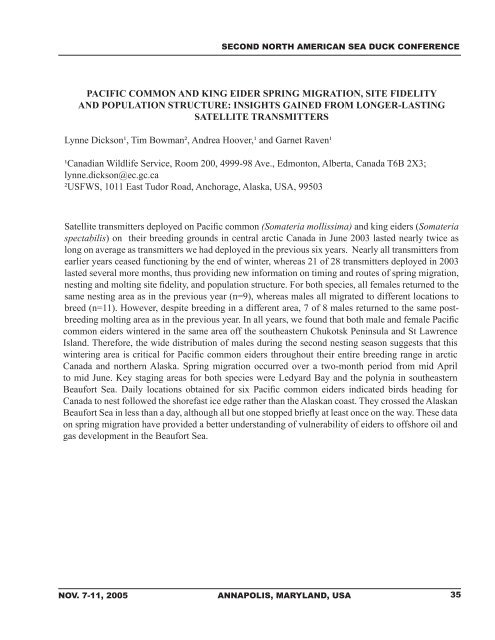Second North American Sea Duck Conference - Patuxent Wildlife ...
Second North American Sea Duck Conference - Patuxent Wildlife ...
Second North American Sea Duck Conference - Patuxent Wildlife ...
Create successful ePaper yourself
Turn your PDF publications into a flip-book with our unique Google optimized e-Paper software.
SECOND NORTH AMERICAN SEA DUCK CONFERENCE<br />
PACIFIC COMMON AND KING EIDER SPRING MIGRATION, SITE FIDELITY<br />
AND POPULATION STRUCTURE: INSIGHTS GAINED FROM LONGER-LASTING<br />
SATELLITE TRANSMITTERS<br />
Lynne Dickson¹, Tim Bowman², Andrea Hoover,¹ and Garnet Raven¹<br />
¹Canadian <strong>Wildlife</strong> Service, Room 200, 4999-98 Ave., Edmonton, Alberta, Canada T6B 2X3;<br />
lynne.dickson@ec.gc.ca<br />
²USFWS, 1011 East Tudor Road, Anchorage, Alaska, USA, 99503<br />
Satellite transmitters deployed on Pacific common (Somateria mollissima) and king eiders (Somateria<br />
spectabilis) on their breeding grounds in central arctic Canada in June 2003 lasted nearly twice as<br />
long on average as transmitters we had deployed in the previous six years. Nearly all transmitters from<br />
earlier years ceased functioning by the end of winter, whereas 21 of 28 transmitters deployed in 2003<br />
lasted several more months, thus providing new information on timing and routes of spring migration,<br />
nesting and molting site fidelity, and population structure. For both species, all females returned to the<br />
same nesting area as in the previous year (n=9), whereas males all migrated to different locations to<br />
breed (n=11). However, despite breeding in a different area, 7 of 8 males returned to the same postbreeding<br />
molting area as in the previous year. In all years, we found that both male and female Pacific<br />
common eiders wintered in the same area off the southeastern Chukotsk Peninsula and St Lawrence<br />
Island. Therefore, the wide distribution of males during the second nesting season suggests that this<br />
wintering area is critical for Pacific common eiders throughout their entire breeding range in arctic<br />
Canada and northern Alaska. Spring migration occurred over a two-month period from mid April<br />
to mid June. Key staging areas for both species were Ledyard Bay and the polynia in southeastern<br />
Beaufort <strong>Sea</strong>. Daily locations obtained for six Pacific common eiders indicated birds heading for<br />
Canada to nest followed the shorefast ice edge rather than the Alaskan coast. They crossed the Alaskan<br />
Beaufort <strong>Sea</strong> in less than a day, although all but one stopped briefly at least once on the way. These data<br />
on spring migration have provided a better understanding of vulnerability of eiders to offshore oil and<br />
gas development in the Beaufort <strong>Sea</strong>.<br />
NOV. 7-11, 2005 ANNAPOLIS, MARYLAND, USA<br />
35












